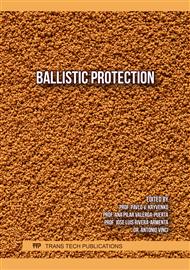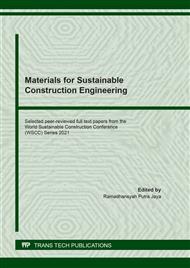[1]
T.A. Rose, P.D. Smith, G.C. Mays, The effectiveness of wall designed for the protection of structures against airblast from high explosives, Proceedings of the ICE-Structures and Building, (1995) 78-85.
DOI: 10.1680/istbu.1995.27306
Google Scholar
[2]
D. Bogosian, D. Piepenburg, Effectiveness of frangible barriers for blast shielding, 17th International Symposium on The Military Aspect of Blast and Shock (2002) 1-11.
Google Scholar
[3]
T. Ngo, N. Nguyen, P. Mendis, An investigation on the effectiveness of blast wall and blast-structure interaction, 18th Australia Conference on the Mechanics of Structures and Materials, (2004) 961-967.
Google Scholar
[4]
D. Yan, G. Chen, J. Baird, H. Yin, M. Koenigstein, Blast test of full-size wall barriers reinforced with enamel-coated steel rebar, Proceedings of the Structure Congress Proc. of the Structure Congress, (2011) 1538-1551.
DOI: 10.1061/41171(401)134
Google Scholar
[5]
H. Radek, F. Marek, F. Josef, Influence of barrier material and barrier shape on blast mitigation, Construction and Building Material, 120 (2016) 54-64.
DOI: 10.1016/j.conbuildmat.2016.05.078
Google Scholar
[6]
L. S. Chao, L. Dan, Y. Bo, Experimental study and numerical simulation on damage assessment of reinforced concrete beams, International Journal of Impact Engineering, 132 (2019).
Google Scholar
[7]
A. Dua, A. Braimah, M. Kumar, Experimental and numerical investigation of rectangular reinforced concrete T columns under contact explosion effects, Engineering Structure, 205 (2020).
DOI: 10.1016/j.engstruct.2019.109891
Google Scholar
[8]
TNB, Contract No. TNB 586/2005 Supply, erect & commissioning of 132kV and 11kV switchgear and ancillary equipment complete with associated civil works at transmission main intake substation in eastern region, (2005).
Google Scholar
[9]
TNB, Contract No. TNB 342/2006 Supply, erect & commissioning of 132kV and 33kV switchgear and ancillary equipment and associated civil works for PMU Teluk Kalong, (2006).
Google Scholar
[10]
L.A. Wyllie, R.W. Laplante, The designer's responsibility for rebar design, Concrete Reinforcing Steel Institute, 1 (2003) 1–16.
Google Scholar
[11]
R. Castedo, P. Segarra, A. Alanon, L.M. Lopez, A.P. Santos, J.A. Sanchidrian, Air blast resistance of full-scale slabs with different compositions: Numerical modeling and field validation, International Journal of Impact Engineering, 86 (2015) 1419-1426.
DOI: 10.1016/j.ijimpeng.2015.08.004
Google Scholar
[12]
G. Thiagarajan, A. V. Kadambi, S. Robert, C. F. Johnson, Experimental and finite element analysis of doubly reinforced concrete wall subjected to blast loads, International Journal of Impact Engineering, 75 (2015) 162–173.
DOI: 10.1016/j.ijimpeng.2014.07.018
Google Scholar
[13]
U.J. Alengaram, N.H.W. Mohottige, C. Wu, M.Z. Jumaat, Y.S. Poh, Z. Wang, Response of oil palm shell concrete subjected to quasi-static and blast loads, Construction and Building Materials, 116 (2016) 391-402.
DOI: 10.1016/j.conbuildmat.2016.04.103
Google Scholar
[14]
L. Jian, W. Chengqing, L. Chunguang, D. Wenxue, S. Yu, L. Jun, C. Ning, Z. Fan, D. Lan, M. Qingfei, P. Jiabao, Blast testing of high performance geopolymer composite walls reinforced with steel wire mesh and aluminium foam, Construction and Building Materials, 197 (2019) 533-547.
DOI: 10.1016/j.conbuildmat.2018.11.207
Google Scholar
[15]
Y. Fei, F. Wanhui, J. Lin, Y. Bing, C. De, Experimental and numerical study of rubber concrete slabs steel reinforcement under close-in blast loading, Construction and Building Materials, 198 (2019) 423-436.
DOI: 10.1016/j.conbuildmat.2018.11.248
Google Scholar
[16]
N. Demetris, K. Antonis, S. Pericles, P. Micheal, Experimental field investigation of impact and blast load resistance of ultra-high-performance fibre reinforce cementious composites (UHPFRCCs), Construction and Building Materials, 95 (2015) 566-574.
DOI: 10.1016/j.conbuildmat.2015.07.141
Google Scholar
[17]
J. Li, C. Wu, H. Hao, Y. Su, X.Z. Li, A study of concrete slabs with steel wire mesh reinforcement under close-in explosive loads, International Journal of Impact Engineering, 110 (2017) 242-254.
DOI: 10.1016/j.ijimpeng.2017.01.016
Google Scholar
[18]
X. Kong, X. Qi, Y. Gu, I.A. Lawan, Y.Qu, Numerical evaluation of blast resistance of RC slab strengthened with AFRP, Construction and Building Materials, 178 (2018) 244-253.
DOI: 10.1016/j.conbuildmat.2018.05.081
Google Scholar
[19]
M. Jin, Y. Hao, H. Hao, Numerical study of fence type blast walls for blast load mitigation, International Journal of Impact Engineering, 131 (2019) 238-255.
DOI: 10.1016/j.ijimpeng.2019.05.007
Google Scholar
[20]
C. Zhao, Q. Wang, X. Huang, Y.L. Mo, Blast resistance of small-scale RCS in experimental test and numerical T analysis, Engineering Structures, 199 (2019) 109610.
DOI: 10.1016/j.engstruct.2019.109610
Google Scholar
[21]
V. Kumar, K.V. Kartik, M.A. Iqbal, Experimental and numerical investigation of reinforced concrete slabs under T blast loading, Engineering Structures, 206 (2020) 110125.
DOI: 10.1016/j.engstruct.2019.110125
Google Scholar
[22]
M.A. Seman, S.M. Syed Mohsin, A.M.A. Zaidi, M.F.S. Koslan, Z.M. Jaini, Experimental of inverted-T shape reinforced concrete wall subjected to blast load, Key Engineering Materials, 879 (2021) 254-262.
DOI: 10.4028/www.scientific.net/kem.879.254
Google Scholar
[23]
M.A. Seman, S.M. Syed Mohsin, A.M.A. Zaidi, Z.M. Jaini, Numerical investigation of steel reinforced concrete wall subjected to blast, IOP Conf. Ser.: Earth Environ. Sci., 682 (2021) 012039.
DOI: 10.1088/1755-1315/682/1/012039
Google Scholar
[24]
W. Riedel, K. Thoma, S. Hiermaier, Penetration of Reinforced Concrete by BETA-B-500 – Numerical analysis using a new macroscopic concrete model for hydrocodes, Proceeding of 9th International Symposium on Interaction of the Effect of Munitions with Structures, (1999) 315-322.
Google Scholar
[25]
W. Herrmann, Constitutive equation for the dynamic compaction of ductile porous materials, J. Appl. Phys, 40 (1969) 2490-2499.
DOI: 10.1063/1.1658021
Google Scholar
[26]
G.R. Johnson, W.H. Cook, A constitutive model and data for metals subjected to large strains, high strain rates and high temperatures,7th International Symposium on Ballistic, (1983) 541-547.
Google Scholar
[27]
M.A. Seman, S.M. Syed Mohsin, Z.M. Jaini, Numerical analysis of blast pressure distribution on RC wall surface, Int. J. of Recent Technology and Engineering, 8-3S3 (2019) 524-531.
DOI: 10.35940/ijrte.c1093.1183s319
Google Scholar
[28]
A. De, Numerical simulation of surface explosions over dry, cohesionless soil, Computers and Geotechnics, 43 (2012) 72-79.
DOI: 10.1016/j.compgeo.2012.02.007
Google Scholar
[29]
H. Hao, Prediction of structural response to dynamic loads of different loading rates. International Journal of Protective Structures, 6 (2015) 145–167.
Google Scholar



